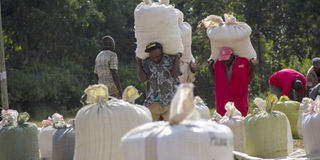Wheat production drops as farmers subdivide land

PHOTO | SULEIMAN MBATIAH Casual labourers carry to a store bags of wheat after sun-drying at Njoro in Nakuru on October 27, 2013. A bag was selling at Sh2,700 but farmers anticipate a higher price by early next year. Despite high yielding varieties suited for major agro-ecological zones being developed, land subdivision has seen wheat production decline in tonnage.
What you need to know:
- The region produces about 4.9 million bags of wheat against an annual consumption of 11 million bags, but land fragmentation has led to declined production.
- The sub-sector is also grappling with post-harvest losses caused by poor storage.
Change of land use in the Rift Valley region has led to a decline in wheat production as farmers continue to sell off their land.
Last season the region produced 4.2 million bags of wheat on 127,825 hectares as farmers located near urban areas sub-divided their land into commercial units.
The region produces about 4.9 million bags of wheat against an annual consumption of 11 million bags, but land fragmentation has led to declined production.
Kenya imports wheat from Egypt and Mauritius under the Common Market for East and Southern Africa (Comesa) treaty to meet the deficit.
“Land sub-division into uneconomical units, environmental degradation and disease outbreak has contributed to low wheat yields in the region,” said Jackson Ng’eno, an agricultural expert in Uasin Gishu County.
He said most wheat farmers citing poor market prices for their crop find it profitable to build rental houses on their agricultural land.
LAND VALUE UP
An acre of land on the outskirts of Eldoret town goes for about Sh2 million.
Mr Ng’eno cited Uasin Gishu, Nandi and Trans-Nzoia as some of the counties that have seen a decline in wheat production.
“The government needs to introduce minimum land units in agricultural-rich areas to safeguard against the sub-division of land into uneconomical units,” said Jane Jeptoo from Uasin Gishu County.
That a bag of wheat is selling for Sh2,600, down from Sh3,300 last year, is also to blame for the crisis.
“The high production costs coupled with unpredictable market prices are rendering wheat farming unprofitable,” said William Kemboi, a farmer in Ziwa, Uasin Gishu County.
The sub-sector is also grappling with post-harvest losses caused by poor storage.
“Disease outbreak and the unreliable rainfall patterns are also to blame for the reduced yield because some farmers are giving up wheat farming,” said Mr Kemboi.
Wheat farmers in the North Rift region suffered losses last year due to an attack of stem rust (Ug99 disease) and rotting caused by heavy rains during harvest period.
“Heavy rains rendered our machines immovable which delayed harvesting and led to rotting of the crop,” said Jackson Kosgei from Moiben, Uasin Gishu County.
Narok County produces more than half the total wheat yield in the country while the rest is harvested in the North Rift region.
Meanwhile, maize production in Rift Valley declined by five million bags, down from 22 million last year to 17 million this season.
The decline has been attributed to the outbreak of the deadly maize lethal necrosis disease.
The viral disease was reported in Bomet, Narok and Nandi counties. Following the breakout, government advised maize farmers to practise crop rotation.
Last week, researchers at the Kenya Agricultural Research Institute announced they had developed a disease-resistant maize seed variety.





